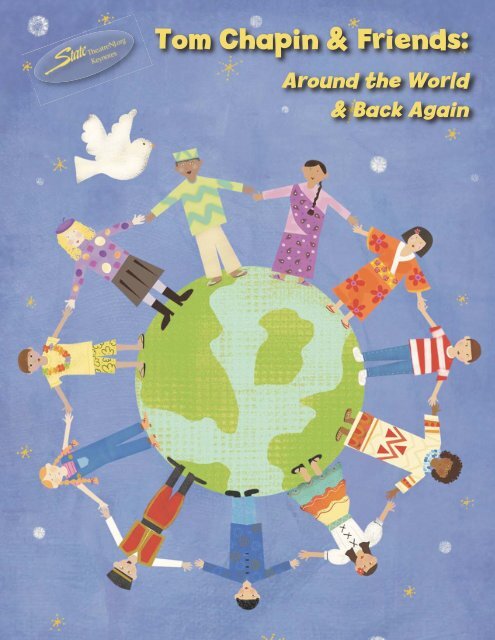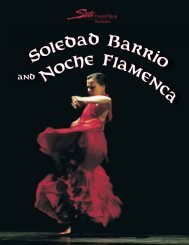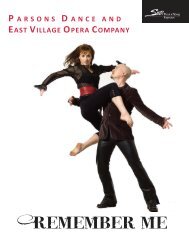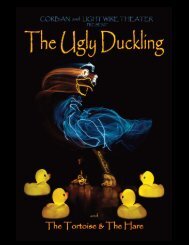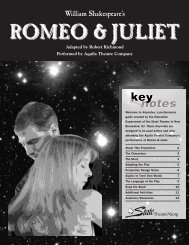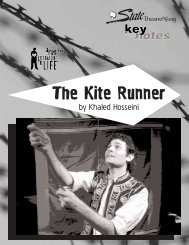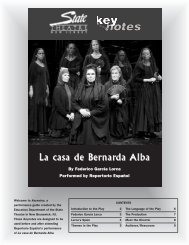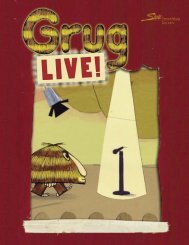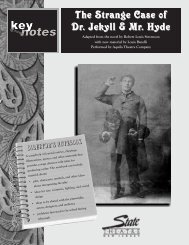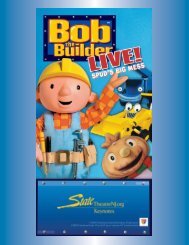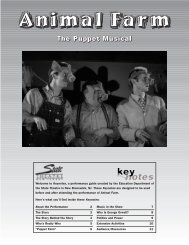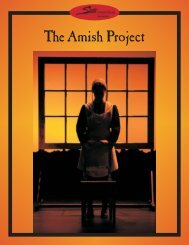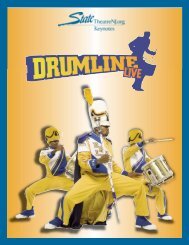Tom Chapin & Friends - State Theatre
Tom Chapin & Friends - State Theatre
Tom Chapin & Friends - State Theatre
Create successful ePaper yourself
Turn your PDF publications into a flip-book with our unique Google optimized e-Paper software.
<strong>Tom</strong> <strong>Chapin</strong> & <strong>Friends</strong>:<br />
Around the World<br />
& Back Again
Welcome! 2<br />
Welcome to <strong>Tom</strong> <strong>Chapin</strong> and <strong>Friends</strong> in Around the World &<br />
Back Again, a musical celebration of the remarkable diversity of<br />
life on our planet. The concert showcases musical styles from<br />
around the world, performed by <strong>Tom</strong> and his good friends<br />
Michael Mark and Jon Cobert. There’s lots of audience<br />
participation to go along with the engaging, toe-tapping music.<br />
These Keynotes provide information and activities that will help<br />
you prepare your students for the performance and then reflect<br />
on what they’ve seen and heard in the show. With younger<br />
students, we encourage you to read the information to them and<br />
facilitate the activities. You will find lyrics and activities for five of<br />
the songs from the show, as well as links where you can listen to<br />
the songs with your students.<br />
CONTENTS<br />
Welcome! ................................................................................................................2<br />
Meet the Band! ....................................................................................................3<br />
<strong>Tom</strong>’s Musical Roots............................................................................................4<br />
The Instruments....................................................................................................5<br />
The Songs:<br />
“Family Tree” ....................................................................................................6<br />
“The Picnic of the World” ..........................................................................7<br />
“A Forest in the Rain” ..................................................................................8<br />
“What Is a Didjeridoo?” ..............................................................................9<br />
“Dinner Soon” ..............................................................................................10<br />
What’s My Job at the Show? ........................................................................11<br />
Resources ..............................................................................................................12<br />
Keynotes are made possible by a<br />
generous grant from Bank of America<br />
Charitable Foundation.<br />
The <strong>State</strong> <strong>Theatre</strong>’s education program is funded in part by Bank of America Charitable Foundation, the Geraldine<br />
R. Dodge Foundation, E & G Foundation, Gannett Foundation, The William G & Helen C. Hoffman Foundation,<br />
Horizon Foundation for New Jersey, Johnson & Johnson Family of Companies, J. Seward Johnson, Sr. 1963<br />
Charitable Trust, Karma Foundation, Blanche and Irving Laurie Foundation, Magyar Bank Foundation, McCrane<br />
Foundation, MetLife Foundation, National Starch, Inc., New Jersey <strong>State</strong> Council on the Arts, PNC Foundation, the<br />
Provident Bank Foundation, PSE&G, Robert Wood Johnson Foundation, TD Bank, and Wachovia Wells Fargo<br />
Foundation. Their support is gratefully acknowledged.<br />
<strong>Tom</strong> <strong>Chapin</strong> & <strong>Friends</strong> is made possible through the generous support of PSE&G.<br />
Funding to the <strong>State</strong> <strong>Theatre</strong> is provided by Mid Atlantic Arts Foundation<br />
in partnership with the National Endowment for the Arts through the<br />
American Recovery and Reinvestment Act of 2009.<br />
Funding has been made possible in<br />
part by the New Jersey <strong>State</strong><br />
Council on the Arts/Department of<br />
<strong>State</strong>, a partner agency of the<br />
National Endowment for the Arts.<br />
Continental<br />
Airlines is the<br />
official airline<br />
of the <strong>State</strong><br />
<strong>Theatre</strong>.<br />
The Heldrich<br />
is the official<br />
hotel of the<br />
<strong>State</strong> <strong>Theatre</strong>.<br />
Keynotes are produced by the Education<br />
Department of the <strong>State</strong> <strong>Theatre</strong>, New<br />
Brunswick, NJ.<br />
Wesley Brustad, President<br />
Lian Farrer, Vice President for Education<br />
Online at www.<strong>State</strong><strong>Theatre</strong>NJ.org/Keynotes<br />
Keynotes for <strong>Tom</strong> <strong>Chapin</strong> & <strong>Friends</strong> written and<br />
designed by Lian Farrer, with additional<br />
material created by Sue Duggan.<br />
Edited by Jennifer Cunha and Katie Pyott.<br />
© 2010 <strong>State</strong> <strong>Theatre</strong><br />
Find us at www.<strong>State</strong><strong>Theatre</strong>NJ.org<br />
Contact: education@<strong>State</strong><strong>Theatre</strong>NJ.org<br />
The <strong>State</strong> <strong>Theatre</strong>, a premier nonprofit venue<br />
for the performing arts and entertainment.
Meet the Band! 3<br />
<strong>Tom</strong> <strong>Chapin</strong> is a Grammy Award-winning musician, singer-songwriter,<br />
guitarist, actor, and storyteller. For more than thirty years and through nineteen<br />
albums, he has entertained and enlightened audiences of all ages with life-affirming<br />
original songs in a wide array of musical styles. His music spans generations and<br />
genres: adult albums and kids’ albums, rock, folk, Latin, blues, pop, and even<br />
classical. <strong>Tom</strong> performs in all kinds of places: on Broadway, on television, and at<br />
outdoor festivals, schools, symphony concerts, and coffeehouses.<br />
His songs and stories deal with the issues that are most important to him: caring for<br />
our planet and caring for each other. <strong>Tom</strong> practices what he teaches, working to end<br />
hunger and homelessness and to protect the environment. (He recently performed at<br />
a benefit concert to raise money for the victims of the earthquake in Haiti). In 2009,<br />
he received the Magic Penny Award, given to artists who have dedicated their lives to<br />
empowering children through music. “If there’s an underlying message to my music<br />
and my existence,” he says, “I think it has to do with empowerment ... the idea that<br />
you matter ... you can make an enormous difference.”<br />
<strong>Tom</strong> comes from a famous musical family that spans several generations. He is the<br />
son of jazz drummer Jim <strong>Chapin</strong> and the brother of the late singer-songwriter Harry<br />
<strong>Chapin</strong> and singer, arranger, and songwriter Steve <strong>Chapin</strong>. <strong>Tom</strong>’s daughters and stepdaughter are the musical trio the <strong>Chapin</strong><br />
Sisters. The whole family occasionally performs together in concerts paying tribute to Harry <strong>Chapin</strong>.<br />
Michael Mark<br />
is perhaps best known for<br />
writing the theme for TV’s<br />
Entertainment Tonight. He<br />
received a Drama Desk<br />
Award for best supporting<br />
actor in the role of Stanley<br />
in the original Broadway<br />
cast of I Love My Wife. In<br />
1981, Michael was cast in<br />
the original production of<br />
Cotton Patch Gospel by<br />
Harry <strong>Chapin</strong>. It was there<br />
that Michael met <strong>Tom</strong> <strong>Chapin</strong>. Michael and <strong>Tom</strong> have<br />
collaborated on music for the children’s musical The Magic<br />
Fishbone.<br />
For more information on Michael, visit his website,<br />
www.myfamilymusic.com.<br />
Jon Cobert, a<br />
native of Brooklyn, plays<br />
piano, organ, accordion,<br />
synthesizer, guitar, bass,<br />
and drums, and also sings.<br />
He grew up listening to<br />
classic rock and Motown, at<br />
the same time studying<br />
classical masters. Jon<br />
collaborated with John<br />
Lennon on several projects,<br />
and toured with Phyllis<br />
Hyman, Laura Branigan,<br />
Klaus Nomi, Jimmy Webb, and Sugarbeats, among others.<br />
He has written the ESPN Baseball Tonight theme, the ESPN<br />
College Football Game Day theme, and many commercial<br />
jingles.<br />
Visit Jon’s website at http://www.cobertoperations.com.<br />
Both Michael and Jon have collaborated with <strong>Tom</strong> as featured musicians on his award-winning<br />
children’s and adult recordings, and they appear in his live concert video. They have each earned 5<br />
Grammy nominations for their work as producers on <strong>Tom</strong> <strong>Chapin</strong>’s recordings.
<strong>Tom</strong>’s Musical Roots 4<br />
“Mine is not a traditional music, but it comes from a<br />
tradition. My musical heroes are people like Pete Seeger<br />
and Woody Guthrie who wrote and sang real songs for<br />
real people; for everyone, old, young, and in between.”<br />
—<strong>Tom</strong> <strong>Chapin</strong><br />
<strong>Tom</strong> <strong>Chapin</strong> comes from a family of<br />
musicians and has been listening to all kinds<br />
of music from the time he was very young. His<br />
music borrows from many different musical<br />
traditions: syncopated Latin rhythms, country<br />
music, blues, rock and roll, bluegrass, and<br />
more. Now and then he even sneaks in some<br />
classical music. (In “Picnic of the World,” the<br />
melody is the famous can-can from Jacques<br />
Offenbach’s Orpheus in the Underworld.)<br />
More than any of these influences, <strong>Tom</strong>’s music is<br />
firmly rooted in the folk tradition. Folk music springs from<br />
the common people. Anyone can understand it, and<br />
everyone is welcome to participate. It can be sung and<br />
played by people who may not have any formal musical<br />
training, using the instruments available to them or—<br />
quite often—homemade instruments. In America, folk<br />
music encompasses many styles, including bluegrass,<br />
country music, gospel, jug bands, Appalachian music,<br />
blues, Cajun, and Native American. Originally, folk music<br />
was not written down, but handed down by oral tradition.<br />
Folk songs can be about civil rights, poverty, war,<br />
work, and of course, love. They can be serious and sad,<br />
lighthearted or satirical. This type of music has a long<br />
tradition of being used for civil protest. Some of the<br />
greatest folksongs grew out of hard times and oppressive<br />
conditions such as slavery, war, the Great Depression, and<br />
unjust labor practices.<br />
As times have changed, folk music has changed to<br />
reflect the times. In the 1960s, musicians such as Bob<br />
Dylan, Joan Baez, Harry Belafonte, and Joni Mitchell<br />
blended folk and mainstream music, creating popular<br />
music with a social conscience. <strong>Tom</strong> <strong>Chapin</strong> continues<br />
that tradition, writing and performing songs that<br />
encourage people to help make our world a better place<br />
for everyone.<br />
Traditional Music<br />
Classical Music<br />
The Blues<br />
Woody Guthrie<br />
Pete Seeger<br />
Bluegrass<br />
Rock and Roll<br />
Latin Music<br />
Pop Music<br />
In the Classroom:<br />
Ask your students to name some problems or<br />
concerns that are important to them. They can<br />
be big issues, such as the environment or<br />
homelessness, or something smaller, such as<br />
having to do chores. Have them brainstorm<br />
some good ways to resolve these problems.
The Instruments 5<br />
Introduce students to some of the many instruments that <strong>Tom</strong> <strong>Chapin</strong> and his friends play during the show. Click on the links<br />
for videos demonstrating each instrument.<br />
ACCORDION - This boxshaped<br />
instrument<br />
has a hollow<br />
chamber that fills<br />
with air when you pull<br />
out the sides of the<br />
instrument. Squeezing<br />
the sides together forces<br />
the air through strips of<br />
metal. The air makes the metal vibrate, producing<br />
the sound. One side of the accordion has keys like<br />
a piano, and the other side has buttons. The keys<br />
are used to play the melody, while<br />
the buttons are used to play the<br />
chords. A smaller instrument<br />
similar to the accordion is the<br />
CONCERTINA, which is held<br />
between the two hands and<br />
has buttons, but no keyboard.<br />
AUTOHARP - This folk instrument<br />
from Germany has been popular in<br />
the U.S. since the late 19th century.<br />
The autoharp is played by<br />
strumming the strings with one<br />
hand, using the fingers or a pick,<br />
called a plectrum. The other hand<br />
controls a system of dampers that<br />
mute the strings that are not being<br />
played. The autoharp has 15 to 20<br />
strings and can be played held<br />
against the musician’s chest or in the lap.<br />
ACOUSTIC GUITAR - The guitar is<br />
played all over the world, in many<br />
different styles of music. It is made from<br />
thin pieces of wood that are glued<br />
together, coated with varnish, and baked.<br />
The body of the guitar is hollow, with a<br />
hole in the front that helps amplify the<br />
sound. Then the six strings are stretched<br />
almost the entire length of the<br />
instrument. The guitar is played<br />
by plucking the strings with<br />
the fingers of the right hand.<br />
With the fingers of the left<br />
hand, the guitarist presses the<br />
strings down against the<br />
fingerboard to make the<br />
different notes. A<br />
guitarist can play just<br />
one string at a time, or<br />
two, three, or even all six<br />
strings at once.<br />
BASS GUITAR - The discovery of electricity led<br />
to all kinds of new musical instruments. The<br />
first electic guitars were made in the<br />
1930s and are now used in almost<br />
every kind of popular music. Unlike<br />
acoustic guitars, electric guitars have<br />
a flat, solid body. While the electric<br />
guitar is used to play the melody,<br />
the bass guitar mostly plays the<br />
bass line: the low notes that help<br />
keep the rhythm.<br />
BANJO - The roots of the banjo reach back to Africa. Enslaved<br />
Africans brought this instrument to America, where it evolved into the<br />
modern banjo. Over time, the banjo became used in many different styles<br />
of folk music, including bluegrass, country, Dixieland, Celtic, and “old-time”<br />
music. The instrument is made from a drum head stretched over a round<br />
wooden hoop and a metal ring. They can have four, five, or six strings.
Listen to<br />
“Family Tree” 6<br />
the song.<br />
Before the days of Jello<br />
Lived a prehistoric fellow,<br />
Who loved a maid and courted her<br />
Beneath the banyan tree.<br />
And they had lots of children.<br />
And their children all had children.<br />
And they kept on having children<br />
Until one of them had me!<br />
We’re a family and we’re a tree.<br />
Our roots go deep down in history<br />
From my great-great-granddaddy reaching up to me,<br />
We’re a green and growing family tree.<br />
My grandpa came from Russia;<br />
My grandma came from Prussia;<br />
They met in Nova Scotia,<br />
Had my dad in Tennessee.<br />
Then they moved to Yokohama<br />
Where Daddy met my Mama.<br />
Her dad’s from Alabama and her mom’s part Cherokee.<br />
We’re a family and we’re a tree.<br />
Our roots go deep down in history<br />
From my great-great-granddaddy reaching up to me,<br />
We’re a green and growing family tree.<br />
by John Forster & <strong>Tom</strong> <strong>Chapin</strong><br />
© 1988 Limousine Music Co. & The Last Music Co. (ASCAP)<br />
maid: a young unmarried woman<br />
courted: asked to marry<br />
banyan tree: a fig tree from India<br />
Teach your students the<br />
words to “Family Tree” in<br />
American Sign Language:<br />
http://64.23.8.93/img/ftsl.jpg<br />
In the Classroom:<br />
• These are the first two verses of “Family Tree.” Explain to your students that <strong>Tom</strong><br />
<strong>Chapin</strong> tracked his family tree back to his grandparents in Russia and Prussia.<br />
Have each student create their own family tree going back as far as they can.<br />
Have them ask parents, grandparents, and other relatives to help. Cut out leaf<br />
shapes and write the name and nationality of each ancestor on each leaf. Have<br />
them glue or tape their leaves to their own tree drawing, or have the entire class<br />
attach their leaves to one big tree.<br />
• Review the vocabulary words (in orange) with your class.<br />
• Help students find the cities, states, and countries mentioned in the song on a<br />
world map. Discuss the different characteristics of the cultures of each location.
Listen to<br />
“The Picnic of the World” 7<br />
the song.<br />
Full of sandwiches and deviled eggs.<br />
We’re all drinking from the same big thermos<br />
At the same big picnic.<br />
It’s the Picnic of the World.<br />
There’s Pakistan, Afghanistan, Malaya, and Nigeria.<br />
There’s Luxembourg and Liechtenstein. Let’s not forget Liberia.<br />
There’s Paraguay and Uruguay; there’s Russia and there’s Syria,<br />
Sudan, Japan, Iraq, Iran, and what about Algeria?<br />
Finland, Greenland, Switzerland, and Vietnam.<br />
Denmark, Norway, Swaziland, and Suriname.<br />
Chile, China, Guatemala, Trinidad.<br />
Tonga, Togo, Portugal, and Chad.<br />
All the nations sitting on a blanket<br />
Having a picnic, the Picnic of the World.<br />
There’s Holland and there’s Poland<br />
And there’s Iceland and there’s Thailand.<br />
There’s England and there’s Scotland and America (that’s my<br />
land).<br />
There’s Canada and Panama; there’s Sweden and Aruba,<br />
Korea, Tanzania, not to mention Greece and Cuba.<br />
All sitting on the same big blanket<br />
With the same warm soda<br />
As the ants crawl on our sandwiches.<br />
We’re all swatting at the same mosquitoes,<br />
Eating burned up burgers<br />
At the Picnic of the World.<br />
There’s Gambia and Zambia and Laos and Guyana.<br />
There’s Libya, Namibia, Andorra, and Botswana.<br />
Then there’s Singapore and Ecuador, El Salvador and Lebanon,<br />
Albania, Rumania. There’s Burma and Bhutan.<br />
Mali, Bali, Mexico, and Martinique.<br />
All sitting on the same big blanket<br />
Hungary, Turkey, India, and Mozambique.<br />
With the same big basket<br />
Haiti, Fiji, Israel, and Senegal.<br />
Full of problems and annoyances,<br />
Kenya, Ghana, Jordan, and Nepal.<br />
But all knowing at the deep down heart of it<br />
We’re all a part of it,<br />
All sitting on the same big blanket<br />
The Picnic of the, Picnic of the, Picnic of the World.<br />
With the same big basket<br />
by John Forster and Jacques Offenbach<br />
© 1990 Limousine Music Co. (ASCAP)<br />
In the Classroom:<br />
• On a map of the world, point out to your students some of the different places named in his song. What<br />
continent is it a part of? How big is it? How many people live there? What language do the people there<br />
speak? What do they eat? What might they wear? How are these places similar to the United <strong>State</strong>s?<br />
How are they different?<br />
• Create a class book about the students and their cultures. Have students draw pictures of themselves.<br />
After everyone has completed an illustration, have students create a brief narrative about themselves<br />
including things they know about their cultural heritage. Punch holes in each page and use binder rings<br />
to keep the class book together.<br />
• Invite students to bring in a food that represents their family heritage and have a class “picnic of the world.”
Listen to<br />
“A Forest in the Rain” 8<br />
the song.<br />
It’s hot in here, forest in the rain.<br />
And wet in here, tropical domain.<br />
Hot in here, wet in here,<br />
Come on down and sweat in here, a<br />
forest in the rain.<br />
A million plants, forest in the rain.<br />
A zillion ants, tropical domain.<br />
Lots of plants, scads of ants,<br />
Across the forest floor they dance, a<br />
forest in the rain.<br />
High up in the canopy, at the top of the tallest<br />
tree,<br />
The monkey and kinkajou are hiding from you.<br />
They eat and they sleep and play and sit on the<br />
branch all day.<br />
They laugh at you on the ground and never, never<br />
come down.<br />
Every night, forest in the rain.<br />
Bats take flight, tropical domain.<br />
Every night bats take flight,<br />
Then back to bed before daylight, a forest in the<br />
rain.<br />
Hummingbirds, forest in the rain.<br />
Don’t know the words, tropical domain.<br />
Hummingbirds don’t know the words<br />
So they hum along with other birds, a forest in the<br />
rain.<br />
The green and the golden frog are having a<br />
dialogue,<br />
Look out for the crocodile, I don’t like his smile.<br />
To every tiny moth, to every three-toed sloth,<br />
To the bee in the honeycomb, the rain forest is<br />
home.<br />
Every tree, forest in the rain.<br />
Says to me, tropical domain.<br />
Every tree says to me,<br />
“Let us grow and let us be a forest in the rain.<br />
Let us grow and let us be a forest in the rain.”<br />
A forest in the rain.<br />
by Michael Mark & <strong>Tom</strong> <strong>Chapin</strong><br />
© 1996 HCD Music & The Last Music Co. (ASCAP)<br />
In the Classroom:<br />
• Ask students what they know about rainforests.<br />
Explain that rainforests are warm year-round and<br />
get a great deal of rainfall. They also contain<br />
more types of trees and more kinds of animals<br />
than any other place on the earth. Many products<br />
people use—such as medicines, nuts, and<br />
rubber—come from the rainforest. Tell students<br />
that the rainforests are disappearing because<br />
people are clearing the land for homes, farming,<br />
or lumber.<br />
• Create a miniature rainforest (also known as a<br />
terrarium) with a plastic soda bottle, soil, plants,<br />
and water. Take the clear plastic of the bottle out<br />
of the colored bottom, and then cut off the spout<br />
(this will be used as the cover). Now fill the dark<br />
plastic bottom with soil and small plants. After<br />
watering the plants, invert the clear plastic over<br />
this small garden so the plants will be covered.<br />
The cover will insure that the moisture stays in<br />
and will help keep the plants alive.<br />
• Ask students what kinds of animal wildlife are<br />
common to their area and list their answers on<br />
chart paper. Make a second list of animals that are<br />
common to a tropical rainforest. Discuss the<br />
similarities (need for food, shelter and climate)<br />
and the differences in the animals on the two lists.<br />
Students can play a guessing game by having one<br />
student pantomime the actions of one of the<br />
animals listed and letting the others guess which<br />
animal is being dramatized.
Listen to<br />
“What Is a Didjeridoo?” 9<br />
the song.<br />
What is a didjeridoo? What is a didjeridoo?<br />
It comes from the land of the kangaroo.<br />
But what does a didjeridoo do? What does a didjeridoo?<br />
I learned all about the Bouzouki<br />
From a Greek with a sweet tooth named Moukie<br />
“I will strum something neat,<br />
Or lovely and sweet<br />
If you give me a chocolate chip cookie.”<br />
But, what is a didjeridoo? What is a didjeridoo?<br />
It comes from the land of the kangaroo.<br />
It goes from your nose to the top of your shoe.<br />
But what does a didjeridoo do? What does a didjeridoo?<br />
In Hawaii I heard ukulele<br />
From a young hula dancer named Haley.<br />
She said, “I love to play while I practice my sway, So I ukulele<br />
daily.”<br />
But, what is a didjeridoo? What is a didjeridoo?<br />
It comes from the land of the kangaroo.<br />
It goes from your nose to the top of your shoe.<br />
It’s a hollow stick that termites chew,<br />
But what does a didjeridoo do? What does a didjeridoo?<br />
Watch and listen to a master didgeridoo player.<br />
I know ‘bout the balalaika.<br />
From a Moscow musician named Micah<br />
He said, “I’m the betsk from here to Plesetsk<br />
‘Cause I play it while riding my bike-a.”<br />
But, what is a didjeridoo? What is a didjeridoo?<br />
It comes from the land of the kangaroo.<br />
It goes from your nose to the top of your shoe.<br />
It’s a hollow stick that termites chew,<br />
Made of eucalyptus or bamboo,<br />
But what does a didjeridoo do? What does a<br />
didjeridoo?<br />
A Caribbean captain named Mongo<br />
Played me sail-away songs on the bongo.<br />
“I wish I could stay-o and play-o all DAY-O.<br />
But my banana boat’s leaving, so long-o.”<br />
But, what is a didjeridoo? What is a didjeridoo?<br />
You pucker and blow and this sucker will buzz<br />
And growl like it’s full of carpet fuzz.<br />
It’s the coolest sound that ever was,<br />
And that’s what a didjeridoo does, That’s what a<br />
didjeri-does (do).<br />
by Michael Mark & <strong>Tom</strong> <strong>Chapin</strong><br />
© 1996 HCD Music & The Last Music Co. (ASCAP)<br />
In the Classroom:<br />
• Explain to students that a didgeridoo is an instrument invented by the native people of<br />
Australia, who are called aborigines (a-bo-RIDGE-uh-neez). The didjeridoo is at least 1,500<br />
years old. It is made out of a long, hollow wooden tube and played by buzzing the lips into<br />
the mouthpiece. Didgeridoo players have a special way of breathing<br />
that lets them hold a note for nearly an hour! The didgeridoo has<br />
an eerie sound that doesn’t sound like any other instrument.<br />
• Ask students how many instruments they can think of and<br />
include the instruments mentioned in the song. What<br />
country does each instrument come from?<br />
• Make a didgeridoo out of a piece of 1½-inch diameter<br />
PVC pipe. Cut a length of pipe about 3-4 feet long<br />
and carefully sand or buff the ends so there are<br />
no rough edges. Choose one end to be the<br />
mouthpiece. Build up layers of duct tape<br />
around the rim of the mouthpiece to<br />
protect your lips when you blow into<br />
it. Decorate the outside of the<br />
instrument with stickers, permanent<br />
markers, colored tape. etc.
Listen to<br />
“Dinner Soon” 10<br />
the song.<br />
It’s gonna be dinner soon. It’s gonna be dinner soon.<br />
I’ve been waiting all afternoon, it’s gonna be dinner soon.<br />
Take a plate, fill your belly, ravioli, vermicelli,<br />
Pizza pie is always cool,<br />
Some spaghetti sauce and a pasta fahzool.<br />
Grab your chopsticks, drop that fork,<br />
Have some egg rolls and moo shoo pork<br />
Hot and sour soup is nice and a bowl of chicken fried<br />
rice.<br />
It’s gonna be dinner soon. It’s gonna be dinner soon.<br />
I’ve been waiting all afternoon, It’s gonna be dinner soon.<br />
From Albuquerque to Cameroon it’s gonna be dinner soon.<br />
I’m holding onto my fork and spoon, It’s gonna be dinner<br />
soon.<br />
Shrimp tempura, teriyaki, ebi, uni, tekamaki<br />
Yellowtail is so delish,<br />
Did you know sushi is a piece of raw fish?<br />
Chili peppers, hot tamale<br />
Can make your tummy melancholy.<br />
But guacamole, salsa, tortilla chips just make me smack my<br />
lips.<br />
It’s gonna be dinner soon. It’s gonna be dinner soon.<br />
I’ve been waiting all afternoon, It’s gonna be dinner soon.<br />
For dessert we’ll have a macaroon. It ‘s gonna be dinner<br />
soon.<br />
Holding onto my fork and spoon, It’s gonna be dinner soon.<br />
What’s that rumbling, grumbling noise?<br />
A hungry herd of girls and boys.<br />
Step up to the world’s buffet;<br />
It’s a smorgasbord and it’s simply gourmet!<br />
Pick a country. Make a wish.<br />
You’re sure to get your favorite dish.<br />
Grab a napkin. Take a seat. Pass the catsup and let’s eat!<br />
It’s gonna be dinner soon. It’s gonna be dinner soon.<br />
I’ve been waiting all afternoon, It’s gonna be dinner soon.<br />
Even couples on their honeymoon are thinking ‘bout dinner<br />
soon.<br />
Holding onto my fork and spoon, It’s gonna be dinner soon.<br />
Bon appétit!<br />
by Michael Mark & <strong>Tom</strong> <strong>Chapin</strong><br />
© 1996 HCD Music & The Last Music Co. (ASCAP)<br />
In the Classroom:<br />
• Play a fun language game by having students name toppings they like on<br />
their pizzas. Have the first child begin by saying “I’m going to make a<br />
pizza with . . . “ Have the second child repeat what the first child<br />
said and add the name of his/her favorite topping to the end<br />
of the sentence. Continue until every child has had a chance<br />
to add a topping name to the list. Use age and ability to<br />
determine when to start the sentence over with the<br />
name of one topping.<br />
• Have students draw their favorite foods (or cut out<br />
pictures from magazines). Have them assemble their<br />
pictures into a collage and glue them to a piece of cardboard or construction paper.
What’s My Job at the Show? 11<br />
Going to see a play at a theater is not the same as watching TV. When you are sitting<br />
in audience at the <strong>State</strong> <strong>Theatre</strong>, the actors will be in the same room as you. They will<br />
be able to hear and see everything that goes on in the audience. Use the key to find<br />
out what your job is at the performance.<br />
watch listen performance audience applaud<br />
When I go to a , I am part of the . This is a very<br />
important job. I have to and carefully.<br />
If I talk or move around, the actors and the<br />
will have a<br />
hard time paying attention to the<br />
. When the<br />
is over, I can<br />
to show that I liked it.
Resources 12<br />
On the Internet<br />
<strong>Tom</strong> <strong>Chapin</strong> sings Picnic of the World, from This<br />
Pretty Planet<br />
http://www.youtube.com/watch?v=WVrKPaiTtmk<br />
<strong>Tom</strong> <strong>Chapin</strong> and company sing This Pretty Planet and<br />
Walk the World.<br />
http://www.youtube.com/watch?v=hOTCM4eFJrE<br />
<strong>Tom</strong> recommends these sites that<br />
help make a difference:<br />
The Hunger Site<br />
www.thehungersite.com<br />
The Child Health Site<br />
www.thechildhealthsite.com<br />
The Literacy Site<br />
www.theliteracysite.com<br />
The Animal Rescue Site<br />
www.theanimalrescuesite.com<br />
The Rainforest Site<br />
www.therainforestsite.com<br />
Music<br />
<strong>Tom</strong> <strong>Chapin</strong>: Around the World and Back Again. Sony<br />
Wonder, 1996.<br />
<strong>Tom</strong> <strong>Chapin</strong>: This Pretty Planet. Sony Wonder, 2000.<br />
<strong>Tom</strong> <strong>Chapin</strong>: Billy the Squid Gadfly, 1992.<br />
<strong>Tom</strong> <strong>Chapin</strong>: Mother Earth. Gadfly, 1989.<br />
Various artists: A Child's Celebration of Folk Music.<br />
Music for Little People, 1996. Artists range from Pete<br />
Seeger and Woody Guthrie to Michelle Shocked and<br />
Sweet Honey in the Rock.<br />
Picnic Playground. Putumayo World Music, 2009.<br />
Artists from around the world perform songs about<br />
food, cooking, and healthy eating in a global gumbo<br />
of musical styles and languages.<br />
Books<br />
<strong>Tom</strong> <strong>Chapin</strong>: Around the World and Back Again, by<br />
<strong>Tom</strong> <strong>Chapin</strong>. Cherry Lane Music, 1998. Illustrations,<br />
teacher’s guide, and lyrics to accompany the album.<br />
The Best of <strong>Tom</strong> <strong>Chapin</strong>: Family Favorites, by <strong>Tom</strong><br />
<strong>Chapin</strong>. Cherry Lane Music, 2006. Teacher’s guide,<br />
lyrics, and sheet music to accompany a variety of<br />
<strong>Tom</strong> <strong>Chapin</strong>’s most popular songs.<br />
Sing a Whale Song, by <strong>Tom</strong> <strong>Chapin</strong> and John Forster,<br />
illustrated by Jerry Smath. Random House, 1993.<br />
Story-songbook about a young boy’s journey of<br />
environmental awareness.<br />
Children Around the World, by Donata Montanari.<br />
Kids Can Press, 2004. This picture book takes young<br />
children on a journey around the globe, where they<br />
meet children from twelve different countries. Grades<br />
Pre-K-2.<br />
The Everything Green Classroom<br />
Book: From recycling to<br />
conservation, all you<br />
need to create an<br />
eco-friendly<br />
learning<br />
environment<br />
(Everything Series), by<br />
Tessa Hill. Adams Media,<br />
2009.<br />
The Kids' Multicultural Cookbook:<br />
Food & Fun Around the World, by<br />
Deanna F. Cook. Williamson<br />
Publishing Company, 1995. Grades<br />
3-6.<br />
Rain Forest, by Helen Cowcher.<br />
Farrar, Straus and Giroux, 1990.<br />
Grades K-2.<br />
Ty’s One-Man Band, by Mildred<br />
Pitts Walter. Scholastic, 1984. A<br />
young boy meets a man<br />
who creates music out of<br />
the simplest materials.<br />
Grades Pre-K-2.


